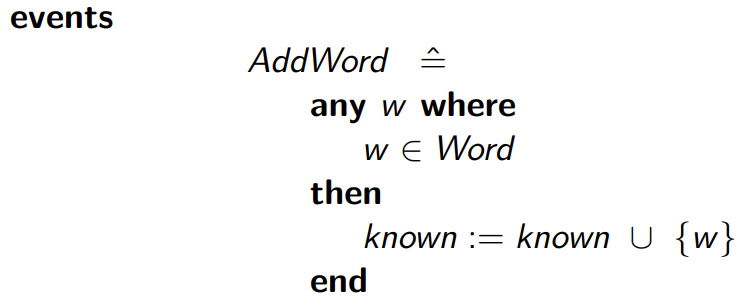- What is Event-B?
- Basic Set Theory
- What is contained in Event-B
- Examples of Event-B
What is Event-B?
- System specifications are derived from requirements.
- System specification is an important precursor to design, implementation and testing.
- Event-B is a formal language for writing high-level specifications of computer systems.
- Event-B language includes logic and set theory.
- Formal specification is more precise and consistent than an informal (natural language) specification.
- Event-B typically used in safety-critical applications.
Basic Set Theory
Set and Elements
- A set is a collection of elements.
- Elements of a set are not ordered.
- Elements of a set may be numbers, names, identifiers, etc.
- Sets may be finite or infinite.
- Relationship between an element and a set: the element is a member of the set.
For element x and set S, we express the membership relation as follows: x ∈ S
Enumeration and Cardinality of Finite Sets
- Finite sets can be expressed by enumerating the elements within braces.
- for example:
{ 3, 5, 8 },{ a, b, c, d }
- for example:
- The cardinality of a finite set is the number of elements in that set:
- For example:
card( { 3, 5, 8 } ) = 3,card( { a, b, c, d } ) = 4,card( {} ) = 0
- For example:
Subset and Equality Relations for Sets
- A set
Sis said to be subset of setTwhen every element ofSis also an element ofT. This is written as follows:S ⊆ T{ 5, 8 } ⊆ { 4, 5, 6, 7, 8 }
- A set
Sis said to be equal to setTwhenS ⊆ TandT ⊆ S(no matter if they have the same number of elements):S = T{ 5, 8, 3 } = { 3, 5, 5, 8 }
Operations on sets
- Union of
SandT: set of elements in eitherSorT.S ∪ T - Intersection of
SandT: set of elements in bothSandT.S ∩ T - Difference of
SandT: set of elements inSbut not inT.S \ T
Example:
{a, b, c} ∪ {b, d} = {a, b, c, d}
{a, b, c} ∩ {b, d} = {b}
{a, b, c} \ {b, d} = {a, c}
{a, b, c} ∩ {d, e, f } = {}
{a, b, c} \ {d, e, f } = {a, b, c}
What is contained in Event-B
- Event-B context contains:
- Sets: abstract types used in specification
- Constants: logical variables whose value remain constant
- Axioms: constraints on the constants. An axiom is a logical predicate.
- Event-B machine contains:
- Variables: state variables whose values can change
- Invariants: constraints on the variables that should always hold true. An invariant is a logical predicate.
- Initialisation: initial values for the abstract variables
- Events: guarded actions specifying ways in which the variables can change. Events may have parameters.
Types
- All variables and expressions in B must have a type.
- Types are represented by sets.
- Let
Tbe a set andxa constant or variable.x ∈ Tspecifies thatxis of typeT.
- All the elements of a set must have the same type.
-
Basic types are introduced to represent the entities of the problem being modelled.
- Types help to structure specifications by differentiating objects.
- Types help to prevent errors by not allowing us to write meaningless things.
- Types can be checked by computer.
Powersets
The powerset of a set S is the set whose elements are all subsets of S.
Predicate Logic
Defining Set Operators with Logic
Examples of Event-B
Simple Event-B model: Counter
Definition
- Invariants define valid system states.
Increasing and decreasing the Counter
- Events define changes to the system state.
- Events have guards and actions.
- Guards must be true for the actions to be executed.
Simple Example: Dictionary
Definition
Increasing and decreasing the Counter
This event has a parameter w representing the word that is added to the set of known words.
Checking if a word is in a dictionary: 2 cases
- Cases are represented by separate events.
- In both cases,
r!represents a result parameter. - We use the
!convention to represent result parameters.
In both cases, result represents a the output parameter.
Example Requirements for a Building Control System
- Specify a system that monitors users entering and leaving a building.
- A person can only enter the building if they are recognised by the monitor.
- The system should be aware of whether a recognised user is currently inside or outside the building.
Definition
Entering and Leaving the Building
Adding New Users
- New users cannot be registered yet.
- Newly registered users must be added either to in or out to preserve inv5.














